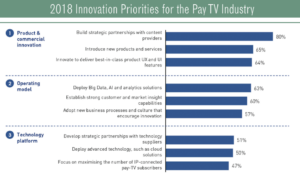M+E Connections

M&E Journal: Transforming Pay TV for Long-Term Success
Story Highlights
By Simon Trudelle, Senior Product Marketing Director, NAGRA –
The global pay TV industry is going through a significant transformation. From evolving consumer demand and rising content costs, to falling barriers to entry and growing competition from a wide range of companies offering attractively-priced and readily- available paid content packages, the time for rethinking content distribution and monetization strategies is now.
Research conducted in 2018 by the Pay-TV Innovation Forum corroborate this sentiment with key findings, including loss of revenue for traditional TV service providers and monetization challenges for upcoming OTT providers, all of which are impacting pay TV and OTT markets worldwide. In fact, 90 percent of executives surveyed believe that to remain competitive, pay TV providers will have to innovate strongly over the next five years.
With the convergence of TV and video streaming, the industry must adapt to the challenges and opportunities in this new landscape. Intense competition confirms the appeal of premium video content, but is also creating downward pressures on pricing, and therefore on pay TV margins.
Working with a history of success and value to millions of subscribers worldwide, pay TV providers remain optimistic they can continue to appeal to paying consumers, while also agreeing that innovation must now be at the core of their strategies.
To accomplish this, the industry is rethinking the way it addresses its customers, becoming more diverse in its business models and embracing innovation. According to research findings, a growing number of service providers are embarking on the next stage of innovation for growth, which requires a carefully orchestrated approach that invests in three key areas:
1. Product and commercial innovation
Strategic partnerships between pay TV platforms and content owners are going beyond traditional buyer-seller interactions and are seen as one of the most important priorities for the pay TV industry by 80 percent of executives. At the same time, pay TV will have to continue to innovate by introducing new products and services and delivering best-inclass UX and UI features.
2. Operating model innovation
In addition to developing new products and services, pay TV providers must focus on digitizing and transforming their business operations. The need to extend beyond a service provider’s technology platform and their IT, engineering and product teams is essential. Pay TV providers need to be able to adapt their processes, control their costs, ideate fast, and move quickly to develop, test and launch new offerings. To do that, they must upskill their teams, introduce new working practices to deliver operational excellence, become more agile and foster a culture of innovation.
3. Technology Platform Innovation
The continued transformation of technology platforms, replacing legacy infrastructure with next-generation flexible solutions, rounds out the top-three list. By choosing the right technology partners and forming strong partnerships will be key factors in determining the success of their technology strategies.
These priorities lay the groundwork for pay TV providers to ensure they are fit for the future and well-positioned to grow and remain competitive. If implemented correctly, providers can address the new consumer expectations and deliver what is needed to drive business growth.
A consumer-centric view to drive results
Understanding viewer behavior and expectations is essential to business growth. The way people consume video content is changing drastically, especially for younger generations and other demographics that appreciate the convenience of anytime, on-demand content on any screen. At the same time, the more traditional viewer cannot be ignored. With this in mind, it is no longer adequate to try to compete on content exclusivity alone.
The user experience (UX) is now one of the key factors that consumers will consider when choosing a provider. A multi-generational user UX that taps into the unique wants and needs of each viewer’s journey is the goal when working to meet customer expectations.
From easy access to on-demand content, start-over, catch-up TV and cloud DVR, to on-boarding OTT apps and content like Netflix, voice search and serving linear channels to any screen, industry leaders have started to evolve their TV platforms to provide more convenience and better access to content.
However, many are still struggling to entice subscribers to fully embrace the new experience. This is either because the content, the service offering (intuitive on-demand features and multiscreen capabilities) or the core features (user-friendly UI, multi-language audio, subtitling) are still insufficient or missing.
The good news is that executing on these changes to achieve better content monetization requires new technology solutions that are now, fortunately, coming to market to help service providers be more agile and value-driven at every step of the pay TV content delivery chain, from origin to consumption.
 The solution is a platform that uses the power of the cloud, data analytics and artificial intelligence (AI) as well as advanced user experience features and UI concepts to improve user engagement and monetization. Yet, securing revenue is also about relying on robust content protection technology and deploying anti-piracy services that leverage forensic watermarking across all distribution networks and screens. This will set the groundwork for new business models of the future.
The solution is a platform that uses the power of the cloud, data analytics and artificial intelligence (AI) as well as advanced user experience features and UI concepts to improve user engagement and monetization. Yet, securing revenue is also about relying on robust content protection technology and deploying anti-piracy services that leverage forensic watermarking across all distribution networks and screens. This will set the groundwork for new business models of the future.
When implemented correctly, providers can maximize content value and deliver a unified, intuitive and seamless user experience across all screens through a unique multi-journey UI. At the same time, a simplified and automated workflow for VOD content can deliver immaculate video quality, advanced audio and subtitling features, secure storage and distribution, and quick-start VOD services to address the many holes left by legacy systems.
With the right partner, service providers can entertain upstream content features that enrich content for viewer consumption, including optimizing and extending the content catalogue, with support for Android TV and apps.
Advanced data analytics and AI are also crucial to pay TV providers’ ability to innovate, providing the insights required to identify new opportunities. They can improve customer retention and reduce churn, deliver personalized experiences and relevant advertising, inform customer acquisition and new product development, and automate customer service and care.
Driving innovation with the right partner
There is no doubt that the next generation of content delivery solutions need to address new content distribution challenges and drive monetization. It is an all-screen play where user experience, content value protection and data analytics are critical components. Pay TV operators cannot afford to let this digital transformation movement pass them by. However, if they do invest in smart solutions, the opportunities are considerable.
Properly executed, next generation solutions will open up new revenue streams and potentially attract a whole new mobile-first customer base. With the right innovation strategy, investments and partners, pay TV service providers have the opportunity to be the aggregator of choice on any device, while also providing an exciting next generation big TV screen experience that all viewers know and love.
As a trusted partner with more than 20 years of pay TV industry experience, NAGRA’s cloud-based, next-gen platform and comprehensive content protection solutions deliver what service providers and content owners need to redefine the paid content industry and stay successful in the years to come.
———–
Click here to translate this article
Click here to download the complete .PDF version of this article
Click here to download the entire Spring/Summer 2018 M&E Journal









